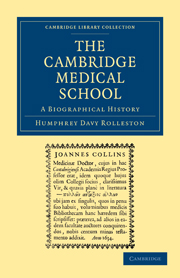Book contents
- Frontmatter
- Contents
- List of Plates
- Preface
- I The Medical School
- II Department of Anatomy
- III Department of Physiology
- IV Department of Biochemistry
- V Department of Experimental Psychology
- VI Department of Pathology
- VII Department of the Quick Chair of Biology
- VIII The Regius Chair of Physic
- IX John Caius
- X The Downing Chair of Medicine
- XI The Linacre Lectureship in Physic
- XII The Chair of Surgery
- Index of Persons
- Index of Subjects
- Plate section
III - Department of Physiology
Published online by Cambridge University Press: 07 September 2010
- Frontmatter
- Contents
- List of Plates
- Preface
- I The Medical School
- II Department of Anatomy
- III Department of Physiology
- IV Department of Biochemistry
- V Department of Experimental Psychology
- VI Department of Pathology
- VII Department of the Quick Chair of Biology
- VIII The Regius Chair of Physic
- IX John Caius
- X The Downing Chair of Medicine
- XI The Linacre Lectureship in Physic
- XII The Chair of Surgery
- Index of Persons
- Index of Subjects
- Plate section
Summary
AS mentioned elsewhere (vide p. 17) the first physiological laboratory in Cambridge may be regarded as that provided by Richard Bentley (1662–1742), Master of Trinity, in what is now the bursary of the college. Here Stephen Hales (1677–1761) first measured blood-pressure and worked at animal and plant physiology in the early years of the eighteenth century. It was not, however, until the last third of the nineteenth century that experimental as distinguished from theoretical physiology found a permanent home in Cambridge. This came about in the following way: recognizing the need, Humphry, who lectured on physiology as well as human anatomy, advocated the establishment of a chair of physiology, but difficulties caused delay; later with the backing of George Eliot (Mary Ann Cross, 1819–1880), George Henry Lewes (1817–1878), and two influential fellows of Trinity, Coutts Trotter (1837–1887) and W. G. Clark (1821–1878), that college was persuaded to create the post of praelector in physiology who should teach the undergraduates of the University as a whole. To this post, which carried a fellowship, Michael Foster was appointed in 1870 on Huxley's recommendation, and brought from University College as his demonstrator Henry Newell Martin (1849–1896), who in 1876 became the first professor of physiology at the Johns Hopkins University, Baltimore. Grace of June 23, 1870, “gave leave to Mr Michael Foster recently elected Praelector in Physiology in Trinity College to give lectures in physiology in one of the rooms in the New Museums Building”.
- Type
- Chapter
- Information
- The Cambridge Medical SchoolA Biographical History, pp. 79 - 97Publisher: Cambridge University PressPrint publication year: 2009First published in: 1932

